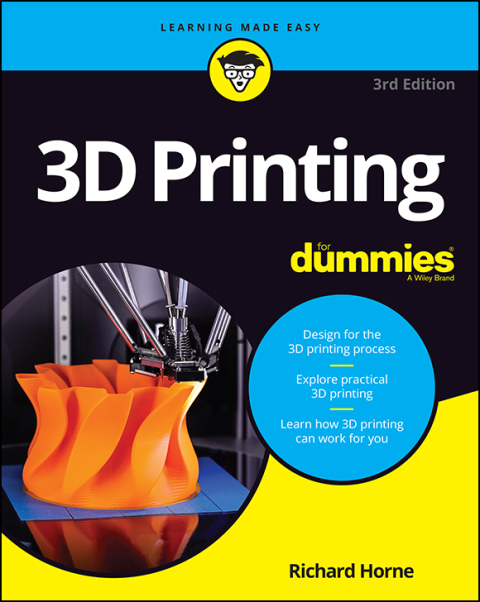Description
Efnisyfirlit
- Cover
- Title Page
- Copyright
- Introduction
- About This Book
- Foolish Assumptions
- Icons Used in This Book
- Beyond the Book
- Where to Go from Here
- Part 1: Getting Started with 3D Printing
- Chapter 1: Seeing How 3D Printers Fit into Modern Manufacturing
- Embracing Additive Manufacturing
- Exploring the Applications of 3D Printing
- Chapter 2: Exploring the Types of 3D Printing
- Exploring Basic Forms of Additive Manufacturing
- Understanding the Limitations of Current Technologies
- Chapter 3: Exploring Applications of 3D Printing
- Looking at Current Uses of 3D Printing
- Designing for the Future with 3D Printing
- Examining Molding and Casting through 3D Printing
- Applying Artistic Touches and Personalization
- Customizing Designs on the Fly
- Part 2: Outlining 3D-Printing Resources
- Chapter 4: Identifying Available Materials for 3D Printing
- Exploring Extruded Materials
- Identifying Granular Materials
- Exploring Photo-Cured Resins
- Understanding Bioprinting
- Identifying Other Uses for Materials
- Chapter 5: Identifying Sources and Communities for 3D-Printable Objects
- Exploring Object Repositories
- Designing in the Computer
- Scanning Objects
- Capturing Structure from Photographs
- Preparing Models for Printing
- Part 3: Exploring the Business Side of 3D Printing
- Chapter 6: 3D Printing for Everyone
- Democratizing Manufacturing
- Building New Tools
- Chapter 7: Understanding 3D Printing’s Effect on Traditional Lines of Business
- Transforming Production
- Handling Challenges to Intellectual Property Laws
- Leveraging Expired Patents
- Imposing Ethical Controls
- Chapter 8: Reviewing 3D-Printing Research
- Building Fundamental Technologies
- Creating Functional Designs
- Expanding Material Selection
- Supporting Long Space Voyages
- Creating Medical Opportunities
- Part 4: Employing Personal 3D-Printing Devices
- Chapter 9: Exploring 3D-Printed Artwork
- Adorning the Body
- Personalizing Your Environment
- Incorporating Individualism in Design
- Visualizing the Abstract
- Sharing Art
- Chapter 10: Considering Consumer-Level Desktop 3D Printers
- Examining Cartesian 3D Printers
- Exploring Delta Options
- Understanding polar Fabrication
- Getting to Know SCARA and Robot Arm Motion
- CoreXY – High Speed FDM 3D Printing
- Building Emerging Alternatives
- Working with Open Innovation and Community Designs
- Examining Printers for More Flexible Materials
- Sampling 3D Food Printers
- Going beyond RepRap
- Chapter 11: Deciding on a 3D Printer of Your Own
- Evaluating Your 3D Printing Needs
- Running a 3D Print Farm
- Licensing and Attribution
- Selecting a 3D Printer Design
- Choosing Print Media
- Identifying Key Components
- Part 5: Understanding and Using Your 3D Printer
- Chapter 12: Assembling Kits and Reviewing Machine Setup
- Sourcing a Kit 3D Printer
- Obtaining Printed Parts for Machine Assembly
- Understanding the Machine Motion
- Building the Printer Frame
- Assembling the Moving Axis
- Connecting the Y Carriage to the X and Z Assembly
- Sensing the Home Position
- Chapter 13: Understanding 3D Printer Control Electronics
- 3D Printer Control Electronics
- Adding Electronics to Your 3D Printer
- Doing Your First Power On Check
- Configuring Firmware
- Chapter 14: Understanding, Using, and Servicing 3D Printers
- Examining Thermoplastic Extrusion
- Working with the Prusa MINI Bowden Extruder and Hot-End Assembly
- Examining the Prusa i3 MK3 and Hot-End Assembly
- Alternative Extrusion Systems for Paste and Edible Materials
- Multicolor Print Methods
- Extruder Operation and Upgrades
- Chapter 15: Identifying Software and Calibrating Your 3D Printer
- Finding 3D Design Software and Models
- Working with PrusaSlicer
- Calibrating Your 3D Printer
- Printing Objects
- Identifying Machine Problems When Print Jobs Fail
- Improving Print Speed
- Chapter 16: Refining the Design and 3D-Printing Process
- Being Productive with 3D Printing
- Refining Your Print Preparations
- Examining a Design Example
- Practical 3D Printing: Looking at Five Quick Examples of Practical 3D Printing at Home
- Designing Parts for 3D Printing
- Postprocessing, Recycling, and Finishing an Object
- Printing Big: Bonding and Joining Parts
- Adopting Green 3D Printing
- Using a Web-Based 3D-Printing Interface
- Part 6: The Part of Tens
- Chapter 17: Ten Examples of Direct Digital Manufacturing and Personalization
- Producing 3D-Printed Food
- Printing Tissues and Organs
- Fashioning Biological Replicas
- Crafting Clothing and Footwear
- Customizing Jewelry
- Making Hollywood Spectacular
- Creating Structures
- Reaching beyond the Sky
- Constructing Robots
- Printing 3D Printers
- Chapter 18: Ten Impossible Designs Created Using Additive Manufacturing
- Personalized Objects
- Medical Implants
- Dental Repair
- Self-Deploying Robots
- Printed Drones and Aircraft Parts
- High Performance, Lightweight Engine Cooling
- Custom Objects Created in Space
- Art on Demand
- Locally Fabricated Items
- Body Parts
- Index
- About the Author
- Connect with Dummies
- End User License Agreement






Reviews
There are no reviews yet.